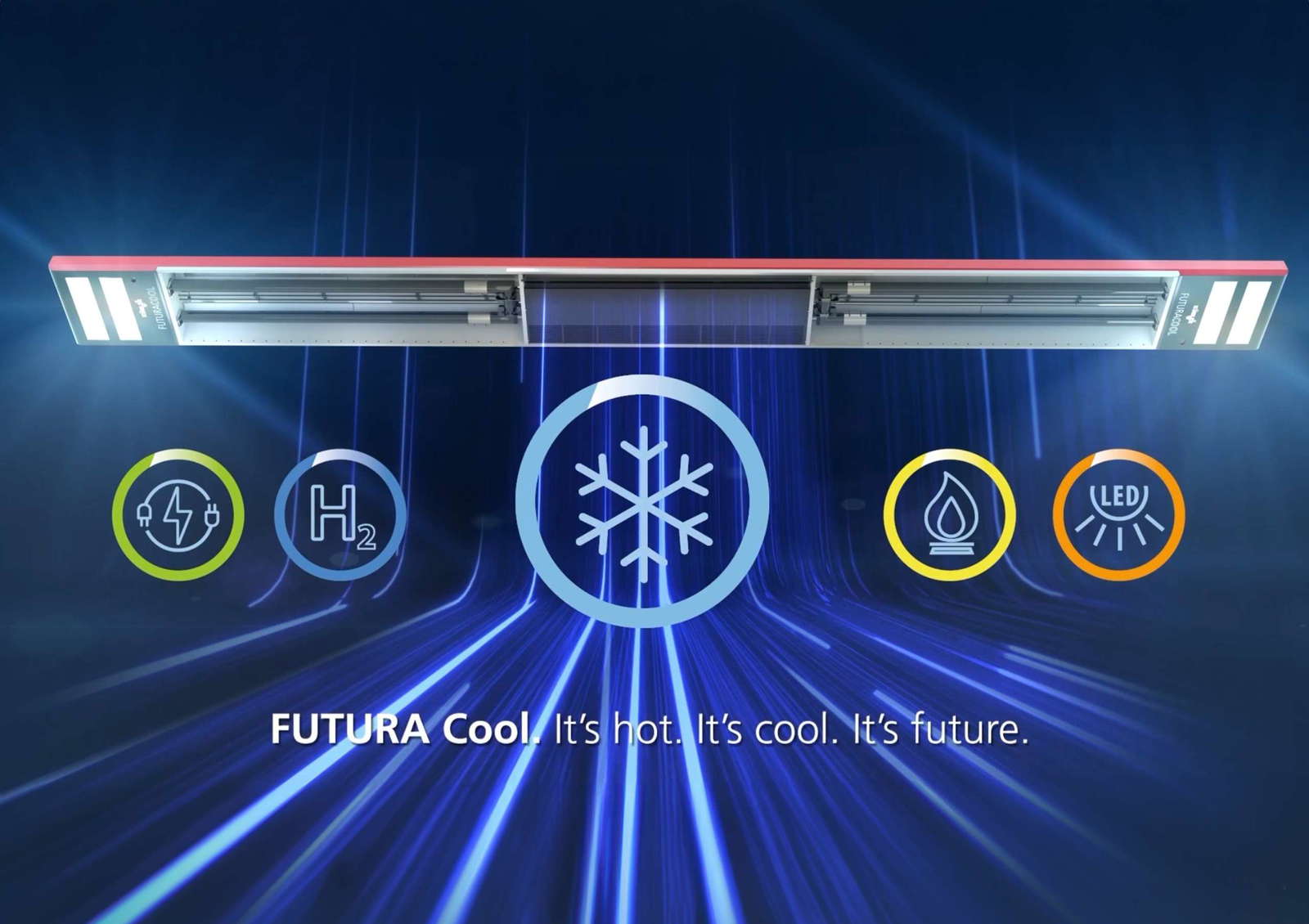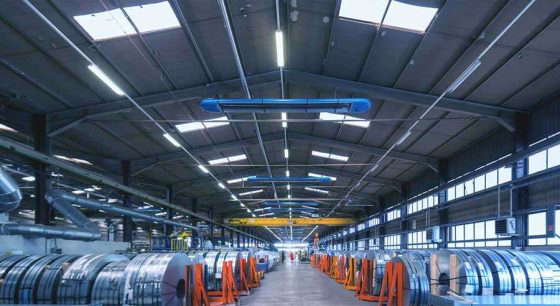Heating with infrared radiant heaters: You should know these facts!

- Saving heating costs sensibly
- Increase energy efficiency
- Creating thermal comfort in the workplace
- Ensure flexibility in operations and
- Fulfill environmental protection requirements and legal requirements
Are you thinking about whether infrared radiant heaters are the right choice? Then these following facts should make your decision easier!
How infrared dark radiators work
Before we get down to the hard facts, we should first clarify two fundamental questions and clear up common misunderstandings. What are radiant heaters and what is the difference between infrared dark radiators and light radiators?
Many of the answers you will find on the Internet are unenlightening or simply nonsense. It is true that both light and dark radiators are radiant heaters, as heat is transferred almost exclusively by infrared radiation. As a rule, natural gas or liquid gas is used as the energy source. However, biogas or hydrogen, e.g. from renewable sources, also have great potential for the future.
Dark radiators use closed combustion in a pipe system. Bright spotlight work with open combustion. The main difference is therefore how the combustion gases are handled: With bright radiators, these initially remain in the hall atmosphere. For this reason, sufficient ventilation must be provided for these systems. With infrared dark radiators, the exhaust air is discharged outside via an exhaust system - without polluting the hall atmosphere. This is why the use of dark radiant heaters is the preferred choice in most applications today.
In both systems, the heat generated is directed into the areas to be heated as infrared radiation. Similar to the sun's rays, heat is generated as soon as the infrared rays hit bodies or objects. For example, the hall floor, the room frame and the people in the work area are heated directly.
The special thing about this is that dark radiators do not heat the ambient air with their infrared radiation, but only directly heat what is actually to be heated. As a result, there is virtually no warm air that rises under the hall roof for physical reasons instead of remaining in the work area. This is precisely the decisive advantage of infrared heaters in terms of efficiency.
No hot air - no air movement
Where there's planing, there's chipping. Or a lot of dust is created. This dust is stirred up by conventional hot air heaters that are often used in halls. This is a problem in many companies, but it can easily be counteracted with infrared dark radiators. These do not heat the air and therefore cannot create draughts or stir up dust. For your employees and visitors, this means a healthy, dust-free and draught-free working atmosphere.
Infrared dark radiators heat particularly efficiently
Let's stay with hot air heating systems, which are usually used in industrial and commercial buildings. Simple physics quickly makes it clear that these are not particularly efficient for heating large halls: After all, the heated air rises straight upwards. To ensure that it is not only warm under the roof, but also in the actual usable area of the hall, it must be continuously reheated. If the hall door is constantly open or the hall is outdated and not sufficiently insulated, this results in an enormous waste of energy and money.
Infrared dark radiators, on the other hand, only heat the objects and bodies they hit, as already described. And if no warm air is generated, no warm air can escape. In addition, the operation of dark radiant heaters can be flexibly adapted to the various situations that work in halls entails by means of a correspondingly intelligent control system:
- Gate opening times
- Working hours and shift times
- Different usage zones in the hall, in which different amounts of heat are required
This means you heat particularly efficiently with infrared radiant heaters. Expressed in clear figures: they consume up to 70 % less energy compared to conventional systems. Modern infrared radiant heaters are therefore probably the most efficient heating systems currently available for industrial and commercial buildings. As a result, you not only quickly recoup the purchase costs, but also do something good for the environment.
No need to worry about GEG & Co.: even high efficiency requirements can be safely met with modern infrared dark radiators
Speaking of environmental protection: Anyone who has not taken care of efficient heating systems and other energy-saving measures in their halls in recent years is increasingly being forced into action. Because in order to achieve the goals of the 2050 climate protection plan, the legislator is calling for the economical use of energy in various ways. Important here are
- the GEG - Building Energy Act (since 01.11.2020) and
- the CO2-tax (since 01.01.2021)
And as far as energy management certifications are concerned, anyone who wants to continue to meet the audits in accordance with the stricter DIN EN ISO 50001 (2018) standard after mid-2021 must also meet increasing efficiency requirements.
The GEG, which summarizes the previous complex energy saving laws, requires, among other things, the increased use of renewable energy sources. The fact that infrared dark radiators work with gas seems to contradict this. Or does it?
No, on the contrary. This widespread misconception arose due to misleading wording in the old legislation and still causes some uncertainty. The fact is, however, that modern infrared dark radiators have always been used in compliance with the law due to their high energy efficiency - both in new builds and refurbishments. The GEG now pays greater tribute to this high efficiency by exempting decentrally heated halls with room heights of over four meters from the obligation to use renewable energies. In addition, gas as an energy source not only has a good primary energy factor. Gas is the technology of the future with great potential as soon as the topic of power-to-gas, i.e. the production of hydrogen, becomes a reality., will be available in large-scale industrial processes. Gas-powered infrared dark radiators will therefore remain the gold standard for energy-efficient heating of hall buildings in the future. And that pays off in the truest sense of the word.
Dark radiators are an investment that pays off. Right from the start.
One mistake that is made particularly frequently when planning hall heating systems is failing to see the big picture. The new devices should be as inexpensive as possible in terms of investment - and this pays off in the long term if the consumption costs are ignored. After all, a hall heating system consumes x times its investment costs over its life cycle. It is therefore important to also focus on the life cycle costs. The keyword here is: low TCO - Total Costs of Ownership. You can save (or spend!) a lot of money at the wrong end without it being really effective in the end.
So which heating system is worthwhile - even in the long term? The answer is: the heating system that best suits your usage profile and meets your economic requirements. Compared to many other systems, infrared dark radiators are characterized by low investment costs. This is confirmed by the results of a study that we carried out together with the Technical University of Kaiserslautern. Investment costs for the use of renewable energies such as a heat pump in conjunction with underfloor heating or a wood pellet stove coupled with radiant ceiling panels are between a factor of 1.8 and 4.0 - on average a factor of 3.0! - higher than with a dark radiator system with residual heat utilization.
Regenerative energies are all well and good in residential buildings, but in halls they are clearly inferior to the dark radiators specially developed for this purpose. This is because renewable energies differ functionally from conventional energy sources in one important respect, and that is the low temperature level. This low temperature level always ties renewable energies to hydraulic solutions, at the end of which is warm air. And warm air as heat transfer in high rooms is dysfunctional, as we have already seen. Who benefits from generating a lot of renewable energy for a lot of money if it then fails to generate the necessary heat in the workplace? Halls have completely different requirements due to the significantly higher rooms.
As already mentioned, infrared radiant heaters also score highly in terms of efficiency and low annual energy requirements. The investment costs are amortized after just a few years. A dark radiant heater therefore clearly pays off in most halls.
Achieve personal and energy policy goals with dark radiators
Regardless of whether your hall is four, ten or more meters high: dark radiators are a sustainable investment that will not only increase the satisfaction and productivity of your employees, but also help you to meet energy policy targets thanks to their high efficiency. Find out more here. If you would like to talk about concrete plans now, Let's have a conversation and discuss the different requirements of your industry.
-
Whether concert fans, art lovers or party enthusiasts: the room temperature also determines the success of events. How hosts ensure a comfortable climate in event halls and exhibition rooms with hall heaters.
-
Infrared hall heating in your production: How to create the right indoor climate for your productionIndoor buildings are a world of their own. Especially in winter. The high rooms pose a real challenge for anyone who wants to ensure the most pleasant working climate possible. But there are solutions - infrared hall heating, for example.
-
While Germany is discussing the energy transition, KÜBLER GmbH from Ludwigshafen has already delivered. FUTURA is the name of the latest invention from the experts for hall heating systems - and it works regardless of the energy source: the infrared heating system for halls uses hydrogen, electricity, gas or a mix of these. It can process green and fossil fuels highly efficiently, thus building a bridge to the carbon-free era. This is one of the reasons why the Investitions- und Strukturbank Rheinland-Pfalz (ISB) and the Ministry of Economic Affairs, Transport, Agriculture and Viticulture awarded KÜBLER the special prize "Innovative Technologies for Climate Protection" at the SUCCESS Innovation Award on Tuesday evening.
-
It is only a small segment, but of great importance: in the current discussion about the energy transition, industrial buildings are being neglected. They only make up two percent of the building stock in Germany. However, they are responsible for around 15 percent of building-related energy consumption and the associated greenhouse gas (GHG) emissions. In the current Building Energy Act (GEG), however, industrial buildings are treated in the same way as daycare centers - and there are indications in a draft bill that the federal government wants to focus exclusively on heat pumps as a technology. KÜBLER GmbH in Ludwigshafen invited experts to discuss this issue. Daniel Föst, construction policy spokesman for the FDP parliamentary group in the Bundestag, announced his intention to change the legislative system.







